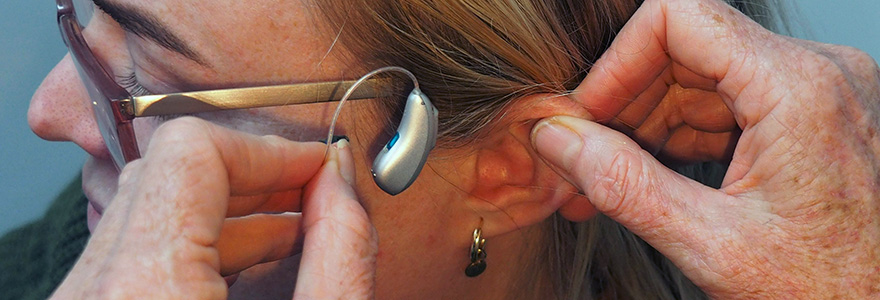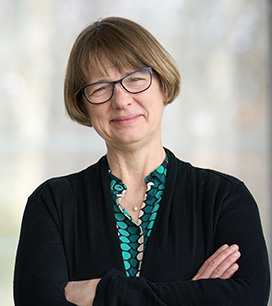FHS researcher’s collaboration bridges academia and industry for hearing care innovation

By Kim McCready
Most have experienced it – struggling to hear a conversation in a noisy restaurant or deciphering a TV dialogue while the dishwasher roars in the background. And, as a person ages, these difficulties only increase.
Ingrid Johnsrude, a professor in the School of Communication Sciences and Disorders and a cognitive psychologist, researches the interplay between hearing loss, speech comprehension and cognitive abilities, seeking ways to improve overall communication, especially for older adults.
“While attempting to understand a person speaking in a quiet room, a clear speech signal is fine, but the real world is more complex,” Johnsrude said. “In busy environments with background noise and competing voices, the spoken word alone often provides insufficient information to be understood by itself.”

Ingrid Johnsrude, School of Communication Sciences and Disorders
As people grow older, hearing deteriorates and sounds become "blurry," similar to the way vision may change. But unlike glasses for the eyes, there's no equivalent for the ears to clarify or focus the sounds. While hearing aids can make sounds louder, they cannot eliminate the blurriness, especially in noisy environments where sounds may overlap.
“A large minority of people over 50 and a majority of people over 80 could have clinically significant hearing loss. And that is the main group that I am working with,” she said.
Johnsrude has forged a valuable partnership with the Eriksholm Research Centre, a part of Oticon, a hearing care company in Denmark. During her recent sabbatical year, she attended work at the centre in person. She has actively engaged in ongoing collaborative efforts with their team, comprised of engineers, physicists, and research audiologists. The blend of their complementary skills provides a unique synergy that is helpful while tackling complex issues surrounding hearing loss and hearing aid technology.
“Working with Eriksholm, I recognized the significance of general cognitive ability in understanding individual variability among people with hearing loss,” she said. “This factor, which has been studied by psychologists for a long time, may account for important differences in how individuals with hearing loss cope in noisy speech situations.”
According to Johnsrude, people with hearing loss tend to cope very differently in noisy speech situations. Part of that difference is their level of hearing loss, but another significant part is their cognitive ability. By accounting for differences in cognitive ability, researchers may be able to reduce individual variability to isolate the ways that hearing loss contributes to difficulty understanding speech.
Johnsrude is excited about Eriksholm’s ongoing projects, including one that is focused on making hearing aids smarter, specifically with intent-controlled features.
Imagine an individual in a group chat, and their hearing aid automatically knows which person they are interested in hearing. The challenge is figuring this out without relying on where they are looking. Many hearing aids today use directional microphones near the eyes or head, but this can be a bit clunky because the individual has to stare at the person they want to hear.
The innovative idea is to use signals from their brain, which can be measured using electroencephalography (EEG), to tell the hearing aid who they want to listen to. This could make the whole process more natural, allowing them to focus on someone in a group conversation without the need for constant eye contact.
"It's about improving the quality of life for those with hearing loss. It's about fostering meaningful connections and their positive emotional impact through effective communication."
In the early stages of research and development, many of Johnsrude and Eriksholm's explorations into hearing care advancement are futuristic and forward thinking, highlighting their potential for real world impact and taking steps that move toward improving functionality and making hearing aids work better in everyday situations.
The collaborative effort between academia and industry provides Johnsrude with fresh perspectives.
“I have identified problems that require solutions, and addressing these issues can significantly benefit people. Being in an applied environment allows me to discern the real challenges, locate bottlenecks, and identify areas where research could genuinely make a difference in assisting individuals with hearing loss,” she said.
Finding solutions to these and other emerging issues can make a real difference.
With the help of advanced hearing aid technology, individuals with hearing loss can actively engage in social interactions, participate in conversations, and enjoy life's sounds. The isolation that often accompanies hearing loss can be significantly reduced, improving mental health and overall life satisfaction.
Efforts of academia and industry in this field open the doors to big ideas, future advancements, and the potential to bridge the gap between hearing assistance and natural auditory experiences.
"It's about improving the quality of life for those with hearing loss. It's about fostering meaningful connections and their positive emotional impact through effective communication," Johnsrude said.

